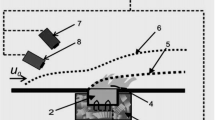Abstract
Heterophase combustion of silane near the first ignition limit was studied. It was found that the reaction of chain initiation on quartz in the zone of hydrogen and silane combustion manifested itself as positive feedback, which was enhanced during exposure of the reactor walls to the products of the low-pressure flame. It was shown that, in a silane-oxygen flame at a temperature of 350–500°C the quartz surface was activated as a catalyst of heterogeneous chain initiation much more strongly than it was in a hydrogen flame. It was shown that the previously found increase in the concentration of atomic hydrogen during oxidation of silane in oxygen below the first limit was related to the formation of new lattice structures saturated with crystal lattice defects, whose number on the wall increases continuously during condensation of the final reaction products, together with adsorption silicon-containing radicals.
Similar content being viewed by others
References
N. N. Semenov, Chain Reactions [in Russian], Goskhimtekhizdat, Leningrad (1934).
H. N. Alyea and F. Haber, “Ignition of hydrogen-oxygen mixture by quartz rod,” J. Phys. Chem., 10, 193 (1930).
N. N. Semenov, Some Problems Chemical Kinetics and Reactivity [in Russian], Izd. AN SSSR (1958).
P. S. Shantorovitsch, “On the kinetics of the oxidation of hydrides in the gaseous phase,” Acta Physicochimica, II, No. 5, 633–646 (1935).
V. V. Azatyan, R. G. Aivazyan, L. L. Vasileva, V. A. Kalkanov, S. M. Repinskii, and A. A. Shavard, “Kinetic features of silane oxidation and role of reversible changes in the properties of the contacting surface,” Kinet. Katal., 25, No. 5, 1033–1040 (1984).
V. V. Azatyan and R. G. Aivazyan, “Heterogeneous chain ignition of silane and participation of the surface in chain branching,” Kinet. Katal., 27, No. 5, 1086–1095 (1986).
V. V. Azatyan, L. L. Vasileva, L. A. Nenasheva, and N. N. Nesterova, “Role of branching-chain mechanism of silane oxidation during formation of silicon dioxide layers,” Kinet. Katal., 28, No. 5, 1068–1072 (1987).
J. R. Hartman, J. Famil-Ghiriha, M. A. Ring, and H. E. O’Neal, “Stoichiometry and possible mechanism of SiH4-O2 explosions,” Combust. Flame, 68, 43–56 (1987).
H. J. Emeleus and K. Stewart, “The oxidation of the silicon hydrides. Part II,” J. Chem. Soc., No. 677 (1936).
E. L. Merryman and A. Levy, “The Rates of Hydrogen Release in Silane-Air Systems,” Battelle Report (1980).
M. Koshi, A. Myioshi, and H. Matsui, “Kinetics of the SiH3 + O2 reaction studied by time-resolved mass spectrometry,” J. Phys. Chem., 95, 9869–9873 (1991).
M. Koshi, N. Nishida, Y. Murakami, and H. Matsui, “Measurement of the absolute concentrations of H and OH produced in the SiH3 + O2 reaction: determination of the product branching ratios,” J. Phys. Chem., 97, 4473–4478 (1993).
Y. Murakami, M. Koshi, and H. Matsui, “Kinetics of SiH3 + O2 reaction: A new transition state for SiO production,” J. Phys. Chem., 100, 17501–17506 (1996).
Atsuko Takahara, Atsumu Tezahi, and Hirouki Matsui, “Production of SiO and Si(3P) atom in the reaction of Silane with O(1D),” J. Phys. Chem., 103, 1315–1320 (1999).
E. N. Aleksandrov and N. M. Kuznetsov, “Quantitative kinetics of oxyhydrogen flame interacting with the reactor surface (development of the scientific heritage of Academician N. N. Semenov),” in: Science and Technologies in Industry, Nos. 1–2, 120–128 (2007).
E. N. Aleksandrov, “Kinetic resonance-fluorescence spectroscopy of low-pressure flames” Doct. Dissertation in Chem. Sci., Inst. of Chem. Phys., Moscow (1986).
E. N. Aleksandrov, S. N. Kozlov, N. M. Kuznetsov, E. A. Markevich, N. N. Sazhina, and V. G. Fomin, “Stimulation of catalytic processes on a quartz surface by the active products of hydrogen and silane combustion,” Dokl. Ross. Akad. Nauk, 409, No. 3, 345–350 (2006).
O. Deutschmann, L. Maier, U. Riedel, A. H. Stroemann, and R. W. Dibble, “Hydrogen assisted catalytic combustion of methane on platinum,” Catalysis Today, 59, 141–150 (2000).
L. Pauling, General Chemistry, W. H. Freeman-Dover, San Francisco (1970).
V. A. Radtsig, “Formation of free radicals during interaction of
 groups with H2, CH4, C2H4 molecules,” Kinet. Katal., 37, No. 2, 302–309 (1996).
groups with H2, CH4, C2H4 molecules,” Kinet. Katal., 37, No. 2, 302–309 (1996).D. G. Permenov and V. A. Radtsig, “Mechanisms of heterogeneous processes in the SiO2 + CH4 system,” Kinet. Katal., 45, No. 2, 284–292 (2004).
V. A. Radtsig and I. N. Senchenya, “Hydrogenation of sylanone groups (≡ Si-O)2Si=O. Experimental and quantum-chemical study,” Izv. Ross. Akad. Nauk, Ser. Khim., No. 8, 1951–1958 (1996).
I. V. Berestetskaya, A. A. Bobyshev, L. S. Gulyaeva, E. A. Markevich, D. G. Permenova, and V. A. Radtsig, “Groups (≡Si-O)2Si(X)(OOH)(X=O-Si≡, OH, NH2, OCH3): Production, structure, and properties,” in: Modern Chemical Physics, Abstracts XVI Symp., Tuapse (2004), p. 192.
I. V. Berestetskaya, L. S. Gulyaeva, E. A. Markevich, D. G. Permenov, E. P. Permenova, and V. A. Radtsig, “Formation of reactive structures on a silica surface,” ibid., p. 193.
A. A. Bobyshev and V. A. Radtsig, “Formation and physicochemical properties of siladioxyrane groups on a silicon dioxide surface,” Khim. Fiz., 7, No. 7, 950 (1988).
V. A. Radtsig E. G. Baskir, and V. A. Korolev, “IR spectroscopic study of the structure of silane groups stabilized on a SiO2 surface,” Kinet. Katal., 36, No. 1, 154–159 (1995).
V. A. Radtsig, É. G. Baskir, and V. A. Korolev, “Germinal silanol groups on a silica surface,” Kinet. Katal., 36, No. 4, 618–625 (1995).
V. A. Radtsig, “Reactive silica — new concepts on the structure of surface defects,” Khim. Fiz., 10, No. 9, 1262–1279 (1991).
Author information
Authors and Affiliations
Corresponding author
Additional information
__________
Translated from Fizika Goreniya i Vzryva, Vol. 46, No. 2, pp. 50–58, March–April, 2010.
Rights and permissions
About this article
Cite this article
Markevich, E.A., Aleksandrov, E.N., Kuznetsov, N.M. et al. Heterophase combustion of silane near the first ignition limit. Combust Explos Shock Waves 46, 162–169 (2010). https://doi.org/10.1007/s10573-010-0025-5
Received:
Revised:
Published:
Issue Date:
DOI: https://doi.org/10.1007/s10573-010-0025-5




 groups with H2, CH4, C2H4 molecules,” Kinet. Katal., 37, No. 2, 302–309 (1996).
groups with H2, CH4, C2H4 molecules,” Kinet. Katal., 37, No. 2, 302–309 (1996).